“Is silicone safe to use?” It’s a question I get ALL the time when we talk about replacing kitchen items that are plastic or contain harmful toxins. The one thing about replacing kitchen products and kitchen items, is that it completely defeats the purpose of making a switch if you don’t make the right switch.
This is exactly why I get so many questions asking is silicone safe. My gut instinct was always yes, but once i had someone ask me that question, I realized that I didn’t actually know WHY it was safer than plastic. And of course, because I want ALL the scientific research to back up a decision, I thought it would be best to start out on the right foot and research the topic thoroughly.
As always, I’m sharing my research and information with you so that you can also make an educated, informed decision on whether silicone is safe for your home. So if you’ve ever asked “Is silicone safe?”, this blog post is for you.
WHAT IS SILICONE?
Silicone, not to be confused with silicon, is made of silica, which is a natural element. It’s similar to sand consistency and it’s one of the most abundant elements in the earth’s crust. The silica is heated to a high temperature and it’s combined with oxygen and other elements like carbon and hydrogen.
Silicone is a type of rubber and pure silicone can also be recycled. However, this is ONLY when using pure silicone, which is the best product to buy anyhow. This is a point that can’t be forgotten when you’re trying to determine “is silicone safe.” (STUDY)
An important thing to remember is that silicone is not completely inert. This means that there is some leaching that will occur in the right circumstances. (STUDY)
It has a lower toxicity and a high heat resistance. Which means in answer to the question, “Is silicone safe?” Yes, in most cases silicone is safer than plastic. However, the application you’re using the silicone in and the type of silicone you’re using will play a HUGE part in the truth of this answer.

WHY IS SILICONE SAFE AND BETTER THAN PLASTIC?
First off, it’s important to understand what harm plastic can cause when it comes in contact with our food. Food contains plasticizers, phthalates, BPA and BPS, all of which are harmful to our bodies and our health. These components of plastic disrupt the endocrine system and stay in our bloodstream for long periods of time.
Plastic is also MORE harmful when it is heated, scratched and next to acidic food. These three circumstances allow the plastic to leach into our food at a faster rate, affecting our bodies more severely. (STUDY)
And while many of us in the US have toxins from plastics in our bodies, there is very little evidence that silicone is present in blood or urine samples on a widespread basis.
Studies have found that siloxanes (an an endocrine disruptor) were released into a mixture of alcohol and water after it was in contact with the silicone for 72 hours. However, when the same circumstances were repeated with breast milk, there was no leaching after six hours (STUDY).
What this tells me is that it all depends on HOW the silicone is used and for how long.
When researching “is silicone safe for home use and kitchen use”, I found that while not all silicone products are manufactured the same, they are in general, safer than plastic.
Silicone is made from naturally occurring elements within the earth in its purest form. Pure silicone has no known health effects at this time, however it has not been as widely tested as plastic.
Overall, You have to make sure you’re finding a pure grade silicone or a food grade silicone in order to make sure the product has no chemical fillers or byproducts. These chemical fillers and byproducts that can be added to silicone can contain harmful materials that affect our bodies.
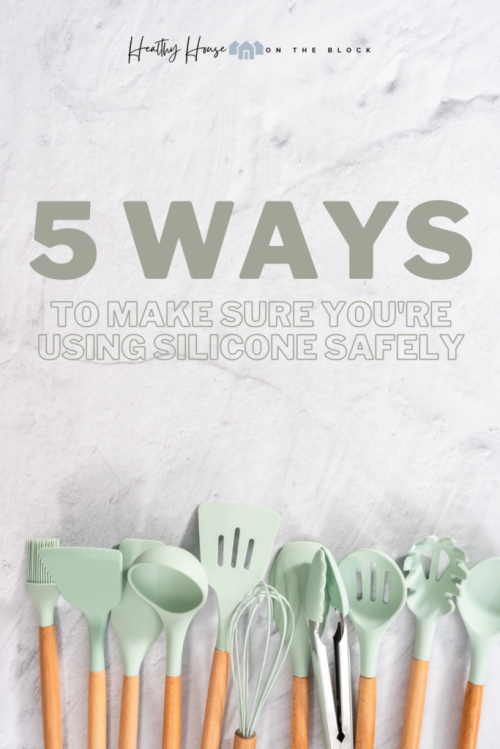
NOT ALL SILICONE IS PRODUCED THE SAME
Some silicone is made inexpensively, and therefore fillers of plastic polymer are added in order to keep their cost down. When plastic polymers and other fillers are added, it means the silicone product is not as safe to use and can leach toxins into food. There is a theory of using a “pinch test” to check the integrity of a silicone product, however it’s not foolproof.
Essentially you pinch and stretch the silicone, it is not supposed to turn white. If it does, it means the silicone is not pure. Personally, I think pure silicone matters when it comes to food storage and long term food contact (like dishes, bottle nipples and storage bags). An item like an oven mitt is something else that isn’t heated with food is less of a concern.
When you’re wondering, “Is silicone safe for food?”, looking for a medical grade silicone is your best bet. Medical grade silicone is a type of silicone that does not contain any fillers or byproducts, making it safer to use with food. Food grade silicone is second best and doesn’t contain any phthalates, BPAs, BPS or any sort of plastic.
Platinum Silicone is another type of silicone that is safer than low grade alternatives. Platinum silicone is a type of silicone that uses the precious metal platinum. It’s an ideal silicone for anything coming into contact with food.

HOW TO USE SILICONE KITCHEN ITEMS
Dishwashing: Silicone is generally dishwasher safe, however, if you start to see white spots appear on your silicone, it should probably just be hand washed. I generally hand wash my silicone storage bags, which are a less dense silicone. Utensils that are silicone are more dense and wash very well in the dishwasher.
Heating: Most silicone can be heated to 600 degrees Fahrenheit, I think I would avoid getting silicone warmer than 300 degrees. In fact, if you can prevent heating silicone at all, I think that’s the safest plan here.
Wash Before Use: In the studies I shared, one of the factors that was present when toxins were released into food and beverages was that the silicone had not been washed. Make sure to wash your silicone products thoroughly BEFORE use of any kind.
Time To Replace: If your silicone items are getting scratches or white spots, it’s probably time to start thinking about replacing them. Generally, if you hand wash them and follow the instructions that came with your product, they hold up really well for a kitchen item.
Short Storage Times: Because studies showed that toxins didn’t start releasing into certain items until after 72 hours, I think it’s safe to say that short term storage of food and beverages in silicone is the best scenario.
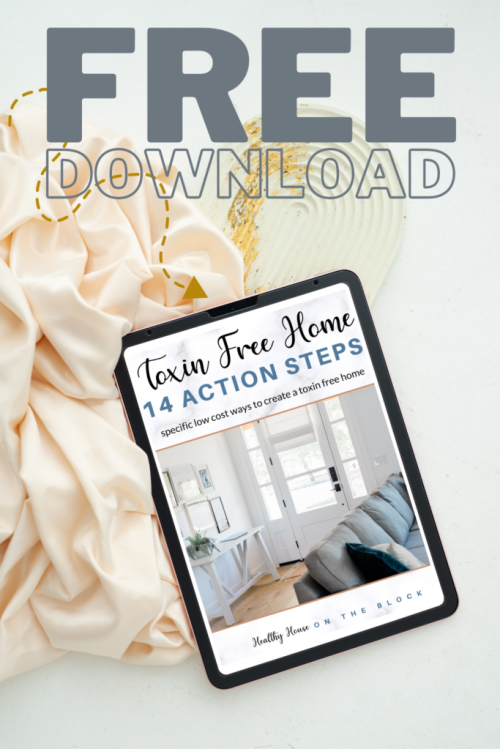
MY FAVORITE SILICONE PRODUCTS TO REPLACE PLASTIC
So while I think silicone is not the BEST option, I will still give it a green light if used in the right application.
Mind you, I know that some of the information you’ll read out there claims silicone should be avoided, however I truly believe that even the “good” options should be explored. Silicone is a great option for smaller budgets and smaller spaces. Not everyone can afford or store glass and stainless steel storage — and that’s okay.
When used the right way, silicone is a great addition to a healthy home.

Share this:
- Click to share on Facebook (Opens in new window) Facebook
- Click to share on LinkedIn (Opens in new window) LinkedIn
- Click to share on Reddit (Opens in new window) Reddit
- Click to share on Pinterest (Opens in new window) Pinterest
- Click to print (Opens in new window) Print
- Click to share on X (Opens in new window) X

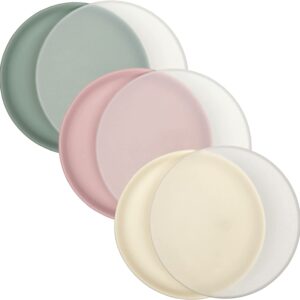


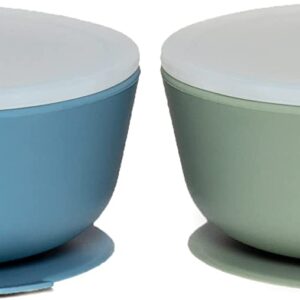
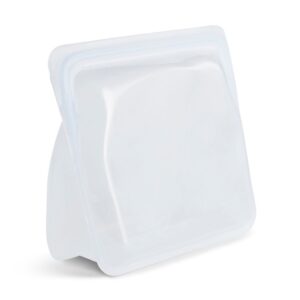

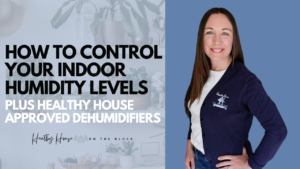

This is an excellent post which I can hardly wait to share. I have replaced all my plastic kitchen tools with food-grade silicone. This disturbed my husband. Now he can read for himself. I receive your newsletter routinely and appreciate your efforts to educate others. Thank you.
Thank you so much for your kind words, Maxx! I’m glad this was helpful!!
What about freezing in silicone? Is the same 72 hour rule best to follow? I stopped using I bleached parchment paper after reading it was coated in silicone which was very sad to me.
Pingback: Healthy Habits for Renters: Whether you Rent a House or Apartment - Healthy House on the Block
I ordered my silicone molds from shein and amazon and I’m pretty sure they’re not fda approved, at least there isn’t any sign of it. What do you think, could they be food safe if I’m only using them for making shaped chocolates and cakepops and keep them in the mold maximum up to 12 hours while freezing them? I don’t heat them, the only heat they get is when I pour in melted chocolate and then put them into the freezer. Or do you think they are already toxic if used like this? I’m trying to find answers online yet I can’t find any.
Hi there! This is a great consideration! There COULD BE some toxin leaching while the chocolate is hot — however it’s still a better option than plastic. And it’s not going to be as toxic as putting the silicone into an oven where it gets even hotter. If you ever notice scratches or discoloration in the molds, then there could be more toxins leaching out — at that point I’d replace them. Hope this is helpful!
thinking of using a silicon loaf pan to put on top of fin like radiator in my bedroom for humidifying. Yea or nay? thanks jdw